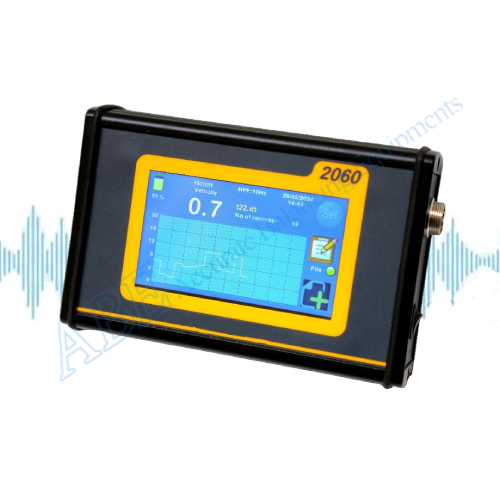

Vibration measuring instruments
The 2060 is a data-logging vibration measurement instrument with a liberal amount of memory for storing historical vibration data pointwise. It is an extremely simple and useful tool for the detection of rising trends and thus aiding condition monitoring based on the trending of vibration measured on specified points on machinery. The graph of the past trend (of the chosen machine) is shown on its graphic display each time a measurement is to be made at a specific point.
Acceleration, Velocity as IS 11724 (ISO2372), Displacement and Bearing Spike can all be measured with the 2060.
NPL traceable calibration is furnished with each unit, and recalibration is also offered after the specified period.
Vibration Measurement with storage of history in a compact and portable hand-held instrument.
True rms measurements as per IS 11724 (ISO 2372) including overall measurements for varying vibration levels. Readings can be colour coded as per ISO level compliance.
Multi- mode instrument for True RMS vibration velocity, bearing spike and Pk-Pk displacement.
4.3” Colour graphic LCD touch-control display
Data transfer via RS232 - USB bridge to a PC.
Mechanical imperfections in any machine create vibrations, the magnitude of which is proportional to the severity of the defect and the frequency is equal to the frequency of the defect. For e.g. unbalance, misalignment, worn bearings or gears, belt defects, etc. Most of these frequencies lie in the IS defined frequency band of 10Hz-1kHz and each of these contribute to the vibration on a tactically selected point on the machine. The root-mean-square of the velocity of vibration represents the energy of the vibration at that point. Each machine under similar conditions will have a stable vibration value, but in case of any defects developing with use, the vibration will indicate a rising trend. In such a case further analysis using Vibration Analysis can lead to pinpointing the nature of the defect (Such analysis is possible with an advanced instrument like the 6090)
The 2060 can be setup to open a file for each point under which all the time-stamped values of vibration can be stored, along with the basic settings. Each time the file is opened on the instrument, the trend of these readings is shown as graph of magnitude v/s reading no.
A simple plant-wide route-based vibration measurement program can thus be easily implemented. The name of the file can be intelligently determined by the user to indicate the queue sequence, if desired. The readings can thus be systematically collected and added to the data record periodically to build a robust database for each point. The readings thus stored can also be transferred to a PC using common software such as Excel, or any commonly used serial terminal software
The unit can also be used on a production line for quality control, saving each measurement time-stamped under a user defined file name. 16GB of storage ensures the unit will practically never run out of memory
Process plants - Cement, Petrochemicals, Chemicals, Steel,Glass, Rayon and Yarn.
Conventional and nuclear power plants.
Air-conditioning plants.
Oil industry-prospecting and refining.
Packaging Film Manufacturers
Automobile and others using CNC machines.
OEM manufacturers of motors, pumps, blowers, impellers, and industrial fans.
Railways
Research and educational.
| Input | Suitable for Baseline accelerometers, sensitivity 2mV/m/sec2 |
| Measurement Modes | Acceleration (RMS-m/sec2); Velocity (RMS-mm/sec); Displacement (PK-Pk microns), Bearing Spike (RMS-m/sec2) |
| Measurement Ranges | |
| Acceleration | 0-199 m/sec2 True RMS |
| Velocity | 0-199 mm/sec True RMS. |
| Displacement | 0-2000 microns Pk-Pk. |
| Frequency Range | ISO 10Hz-1kHz (600-60,000 Cycles per minute) |
| Measurements | The unit is provided with 16GB of storage which can store data for a practically unlimited number of points, including time, mode, and value. Each point consumes less than 100bytes of memory. |
| Display | 4.3" Graphic Touch Controlled LCD display with historical trend graph of vibration for each point. |
| ISO 2372 | The readings can be classified as per relevant category of ISO 2372 and the display of the reading is colour coded as per the levels: Green for A, orange for B, and red for C |
| Printer | Optional 3064 Portable thermal printer for printing historical record of each point. |
| Communication with PC | The data can be transmitted to a PC through RS232 - USB bridge included in the standard accessories as a CSV file using Excel or any terminal software on your PC. |
| Dimensions | 170 mm (L) x 110mm (W) x 45mm (H) Supplied fitted in a foam-lined case |
| Battery | Internal rechargeable Li-Ion battery. Approx charge life of 8 hours continuous use (depending upon use case). |
| Battery charger | Separately supplied as standard accessory |
| Temperature range | 0-45 Deg C upto 90% humidity (non-condensing) |
| Weight | 650 grams approx. without carrying case |
| Standard Accessories | Sensor with 2m lead, Touch Probe, Magnetic base, AC Charger, carrying case, Operation Manual |
| Optional Accessories | Mini Thermal Printer 3064, Printer Rolls |